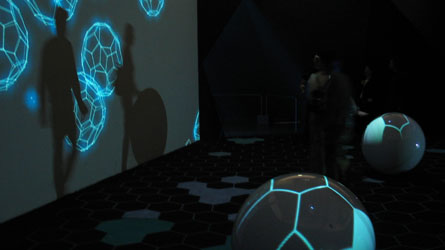|
INNER CELL:All life as we know it, except for viruses, is based on the smallest living unit - the cell. Capable of self-sustaining existence and replication, the cell directly inspires the central space of the NANO exhibit. The exhibit's tessellated architecture spirals towards the Inner Cell, the center of the exhibition, and functions as an analogy with nano space. The interior environment of the Cell provokes a challenge to the visitor's senses, complicating bodily perception and comprehension of scale. Pervasive computing techniques (camera tracking, floor robots, multiple projections, and focused sound) create an immersive environment that elicits "chemistry" between the human visitors, exhibition robots, and molecular representations. Inside the cell, visitors experiment with a large-scale projection of buckyballs programmed to respond to the touch of the visitor's shadow. Subtle action affects the buckyballs, replicating atomic behavior. This virtual and metaphoric cell-space provokes visitors to discover through physical engagement, to learn by feeling. Visitors can experience the act of manipulating atoms and encounter the effects of their bodily movements on the surrounding space. Physical movement triggers reaction from the environment of the Cell, creating "gravity waves" on the floor and setting off sound effects. Everything within the space responds to touch and thereby encourages experiential learning and discovery. SOUND:The main sound feature of the inner cell is a deep, pulsing bass. The heartbeat of the installation. The interactive buckyballs projected onto the cell's walls emit a chiming sound that compliments the bass frequency. The surrounding sound immerses the visitor into the world of nano. |
|
